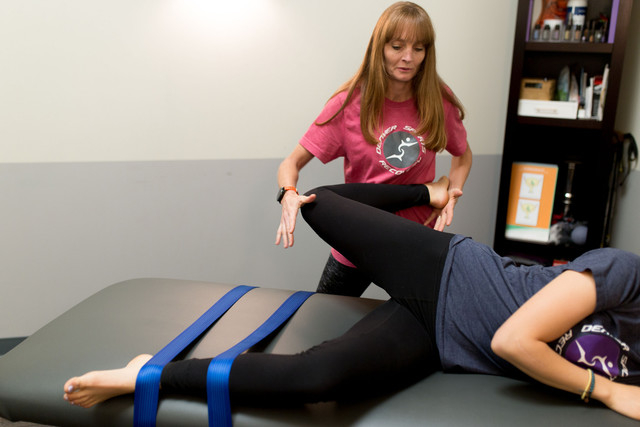Fascial Stretch Therapy (FST) is a unique system of assisted stretching focused on the fascia, the connective tissue that surrounds muscles, bones, and joints. Developed by Ann Frederick and Chris Frederick, FST aims to improve flexibility, strength, and overall well- being by targeting the fascial network rather than just isolated muscle groups.
Key Concepts of FST
1. **Fascia**: Fascia is a continuous web of connective tissue that encases muscles, organs, and structures within the body. It plays a critical role in movement, stability, and overall function. Tight or restricted fascia can lead to pain, reduced mobility, and compromised performance.
2. **Assisted Stretching**: In FST, a trained therapist performs stretches on a client, using techniques that involve gentle traction and movement across multiple planes. This approach helps to release restrictions in the fascial network more effectively than traditional static stretching.
3. **Pain-Free Stretching**: FST focuses on pain-free stretching, which means that the stretches are designed to stay within a comfortable range of motion. This encourages relaxation and allows the fascia to release without triggering the body's protective mechanisms that can cause further tightness.
4. **Holistic Approach**: FST addresses the entire fascial system, including the joints, ligaments, tendons, and muscles. This holistic approach ensures that the body's interconnected structures are all addressed, leading to more comprehensive improvements in flexibility and function.
Benefits of Fascial Stretch Therapy
G2
1. **Increased Flexibility**: FST has been shown to significantly improve flexibility by targeting and releasing tight fascia. This can enhance athletic performance and reduce the risk of injury (Bradbury-Squires et al., 2015).
2. **Improved Range of Motion**: By focusing on the fascial network, FST helps to improve joint range of motion, making movements more efficient and less restricted (Nelson, 2006).
3. **Pain Reduction**: FST can alleviate chronic pain caused by fascial restrictions. By improving the flexibility and function of the fascia, it can help to reduce discomfort associated with conditions such as back pain and fibromyalgia (Schleip et al., 2012).
4. **Enhanced Circulation and Recovery**: The stretching techniques used in FST can improve blood flow and lymphatic drainage, promoting faster recovery from workouts and injuries (Findley, 2013).
Research and Evidence
- **Bradbury-Squires et al. (2015)** conducted a study demonstrating that fascial stretch therapy significantly increased hamstring flexibility and improved functional movement patterns in athletes.
- **Nelson (2006)** highlighted the importance of addressing fascial restrictions to improve overall movement efficiency and reduce the likelihood of injury.
- **Schleip et al. (2012)** explored the relationship between fascial health and chronic pain, emphasizing the potential of therapies like FST in managing pain.
- **Findley (2013)** reviewed the benefits of myofascial release techniques, including improved circulation and recovery, which are also key outcomes of FST.
Conclusion
Fascial Stretch Therapy is a comprehensive and effective approach to improving flexibility, reducing pain, and enhancing overall physical function. By focusing on the fascial network, FST offers a holistic solution that addresses the root causes of many musculoskeletal
issues.
**References**:
- Bradbury-Squires, D. J., Noftall, J. C., Sullivan, K. M., Behm, D. G., Power, K. E., & Button, D. C. (2015). Roller-massager application to the quadriceps and knee-joint range of motion and neuromuscular efficiency during a lunge. *Journal of Athletic Training*, 50(2), 133-140.
- Nelson, R. T. (2006). A comparison of the immediate effects of eccentric training vs. static stretch on hamstring flexibility in high school and college athletes. *North American Journal of Sports Physical Therapy: NAJSPT*, 1(2), 56.
- Schleip, R., Müller, D. G., & Klingler, W. (2012). Active fascial contractility: Fascia may be able to contract in a smooth muscle-like manner and thereby influence musculoskeletal dynamics. *Medical Hypotheses*, 65(2), 273-277.
- Findley, T. W. (2013). Fascia research from a clinician/scientist's perspective.
*International Journal of Therapeutic Massage & Bodywork*, 6(4), 4-9.

